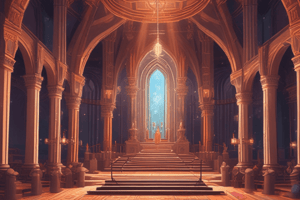Podcast
Questions and Answers
What is the primary purpose of the three-point lighting technique in video production?
What is the primary purpose of the three-point lighting technique in video production?
What is the primary function of the key light in three-point lighting?
What is the primary function of the key light in three-point lighting?
What is the effect of not using a fill light in three-point lighting?
What is the effect of not using a fill light in three-point lighting?
What is the typical position of the fill light in three-point lighting?
What is the typical position of the fill light in three-point lighting?
Signup and view all the answers
What is the purpose of the backlight in three-point lighting?
What is the purpose of the backlight in three-point lighting?
Signup and view all the answers
What is the typical characteristic of the fill light in comparison to the key light?
What is the typical characteristic of the fill light in comparison to the key light?
Signup and view all the answers
What is the primary purpose of a back light or rim light in a three-point lighting setup?
What is the primary purpose of a back light or rim light in a three-point lighting setup?
Signup and view all the answers
How does a kick light differ from a back light or rim light?
How does a kick light differ from a back light or rim light?
Signup and view all the answers
What is the primary function of the background light in a four-point lighting setup?
What is the primary function of the background light in a four-point lighting setup?
Signup and view all the answers
Why is three-point lighting a crucial technique for filmmakers?
Why is three-point lighting a crucial technique for filmmakers?
Signup and view all the answers
What is the benefit of using a four-point lighting setup?
What is the benefit of using a four-point lighting setup?
Signup and view all the answers
What is essential to achieve the desired effect in a three-point lighting setup?
What is essential to achieve the desired effect in a three-point lighting setup?
Signup and view all the answers
Study Notes
Lighting for Video Production: Understanding Three-Point Lighting
Three-point lighting is a standard method used in visual media, including theatre, video, film, and still photography, to create a three-dimensional look and control the shading and shadows produced by direct lighting. This technique involves using three separate light sources placed at strategic positions around the subject.
Key Light
The key light is the primary source of illumination and shines directly upon the subject. Its strength, color, and angle determine the overall lighting design of the shot. In indoor shots, the key light is commonly a specialized lamp or a camera's flash. In outdoor daytime shots, the sun often serves as the key light, but the photographer must arrange the shot to best capture the sunlight.
Fill Light
The fill light shines on the subject from a side angle relative to the key, often at a lower position than the key (around the level of the subject's face). It balances the key light by illuminating shaded surfaces and lessening or eliminating chiaroscuro effects. The fill light is usually softer and less bright than the key light, and more to a flood. Not using a fill light at all can result in stark contrasts across the subject's surface, depending upon the key light's harshness.
Backlight
The backlight, also known as the rim, hair, or shoulder light, shines on the subject from behind, often to one side or the other. It gives the subject a rim of light, serving to separate the subject from the background and highlighting contours. Back light or rim light is different from a kick in that a kick contributes to a portion of the shading on the visible surface of the subject, while a rim light only creates a thin outline around the subject without necessarily hitting the front surface of the subject at all.
Four-Point Lighting
The addition of a fourth light, the background light, makes for a four-point lighting setup. The background light is placed behind the subject(s), on a high grid, or low to the ground. Unlike the other three lights, which illuminate foreground elements like actors and props, it illuminates background elements, such as walls or outdoor scenery. This technique can be used to eliminate shadows cast by foreground elements onto the background, or to draw more attention to the background. It also helps to offset the single eye nature of the camera, which means it helps the camera give depth to the subject.
Three-point lighting is a crucial technique for filmmakers, as it helps to create a professional and cinematic look for their projects. It is essential to understand the placement and intensity of each light source to achieve the desired effect.
Studying That Suits You
Use AI to generate personalized quizzes and flashcards to suit your learning preferences.
Description
Learn about the fundamental technique of three-point lighting in video production, including the key light, fill light, and backlight. Understand how to use each light source to create a professional and cinematic look in your projects.




